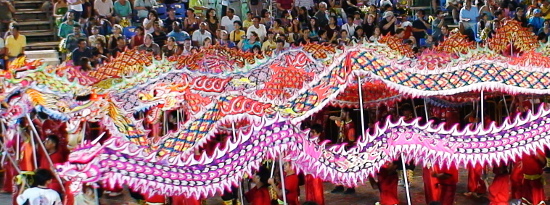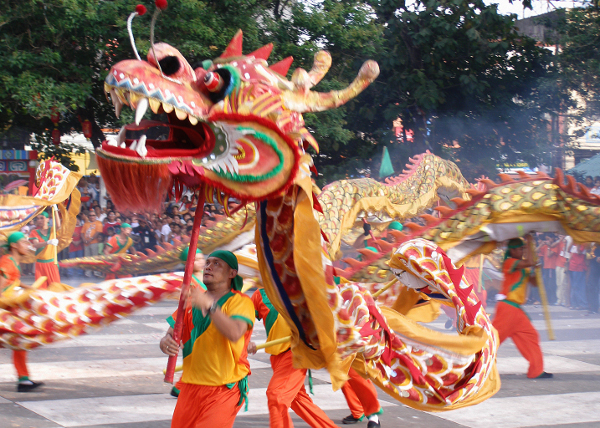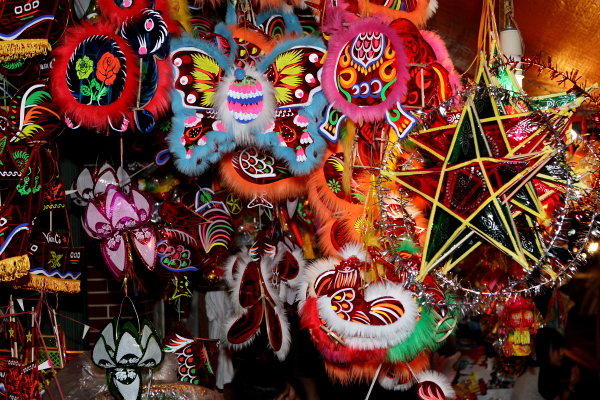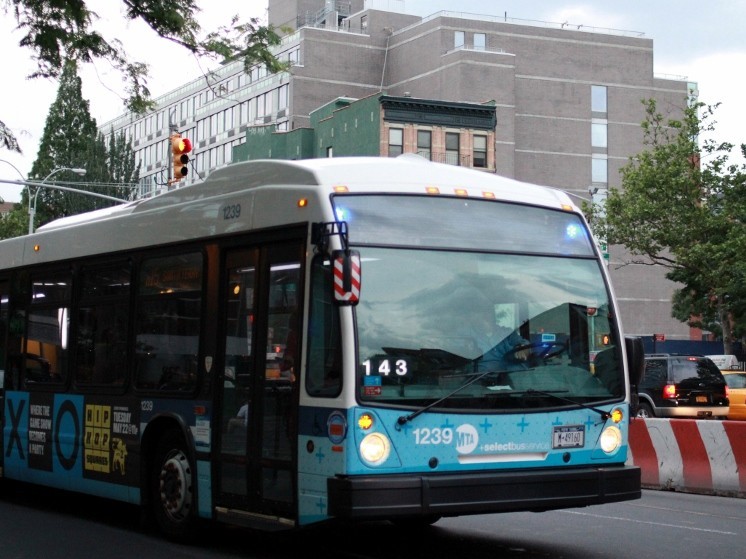The Chinese New Year, the Lantern, Mooncake and the Qingming Festivals explained, and where to go if you are hankering for food associated with these celebrations.

May 21, 2016
The richness and grandeur of China’s history and culture are on full display in the festivals and holidays that Chinese people celebrate throughout the year. These festivals are observed by Chinese communities all over the world, including the Chinese American community here in New York City.
Here are brief descriptions of four of China’s major festivals, and how they are celebrated here, in Manhattan’s Chinatown.
1. Chinese New Year

The Chinese New Year, or Spring Festival, is the biggest Chinese festival both socially and economically. Its origin can be traced to the Shang Dynasty (1600 BC -1046 BC).
The celebration of Chinese New Year serves a dual societal purpose. First, it is a religious and social guide to enforce the power of the Shang Dynasty by appeasing one’s ancestors through participating in time-honored rituals.
These rituals include a detailed cleaning of one’s home – as a means to rid yourself of the bad qi or bad energy that had accumulated throughout the year – and ritual sacrifices of paper goods and foods. Firecrackers were set off to ward off evil spirits. Elders gave out money to children in red envelopes as a means to bring good life and longevity.
The second purpose of the festival is to send a signal to the farmers that spring is arriving.
Food plays an important role in Chinese New Year. Dumplings are vital to the New Year feast; their significance lays in their shape, which is similar to the shape of a Chinese golden nugget. Sticky rice or nian gao is a traditional staple during this holiday because the shape of the grains resembles pieces of gold. The hope is that it will raise the level of prosperity and success, both in one’s career and livelihood. Noodles are eaten during the festival to bring about longevity.
Fish is vital to the festival’s cuisine as fish in mandarin Chinese is “yu”, which can also mean plentiful or abundant. Eating fish is believed to bring about an abundance of food for the whole year.
On the Gregorian calendar that most Western nations use, the Chinese New Year can be anywhere from late January to mid-February.
Chinatown Celebration and Festivities
Annual Chinatown New Year’s Parade
Free
The parade starts at Mott Street from Canal Street, continues onto East Broadway and curves up through Sara Roosevelt Park via Forsyth and Eldridge Streets to Broome Street.
Firecracker Ceremony and Cultural Festival
Free
Roosevelt Park between Grand and Hester Streets
The holiday is celebrated with firecrackers and fireworks to ward off evil spirits. A large stage usually features performances of traditional and contemporary Chinese singing and dancing. A parade of lions, dragons and unicorns will march through the streets of Chinatown following the performances.
Lunar New Year Family Festival
Museum of Chinese in America.
215 Centre Street between Howard and Grand Street.
Tickets: $10/person; $8 for all MOCA dual and individual level members; Free for all MOCA family-level members and above.
Families can learn about the history of the Lunar New Year, play classic Chinese games, engage in the Chinese art of paper-cutting, watch lion dances and performance by Chinatown’s Red Silk Dancers. Activities vary from year to year.
Where to go for traditional New Year’s Festival food
Hop Kee
21 Mott Street
Hop Shing
9 Chatham Square
New Golden Fung Wong Bakery
41 Mott Street
Vanessa’s Dumpling House
118 A Eldridge Street
____________________________________________
2. Lantern Festival (Yuan Xiao Jie)

The Lantern Festival is the Chinese festival celebrated on the 15th day of the first month of the lunar calendar. The festival falls on the first full moon of the New Year, celebrating the return of spring and the end of the Chinese New Year.
The festival can be traced back to the Eastern Han Dynasty (25 AD – 220 AD). Emperor Hanming Di, a supporter of Buddhism, heard that monks liked to light lanterns on the 15th day of the first lunar month. Liking this idea, he decided that all temples, households, and palaces should light lanterns on the same evening. Lighting and appreciating lanterns is seen as a way to express good wishes for the future of one’s family.
Dragon dancing is held at the closing of the Chinese New Year as a means to ward off evil spirits and to usher in good fortune and safety in the coming year. The dragons move from shop to shop, collecting cabbages and red envelopes.
During this holiday, it is customary to eat tang yuan or yuan xiao. These are round soup balls for which the festivity is named. They are made from glutinous rice flour, with different fillings inside, usually sweet. Most common fillings are peanuts with brown sugar, sweet black sesame paste, and sweet red bean.
The tang yuan is generally steamed and served in fermented sweet water. The round shape of the balls symbolizes wholeness and togetherness, both of which are said to express best wishes for the family’s future. The Lantern Festival celebration is usually held anytime from early February to early March.
Chinatown Celebration and Festivities
Annual Chinatown Closing of the New Year Dragon Dance
Free
The Parade starts at Mott Street from Canal Street, continues onto East Broadway and curves up through Sara Roosevelt Park via Forsyth and Eldridge Streets to Broome Street.
Where to go for Tang Yuan
A-Wah
5 Catherine Street
Joe’s Shanghai
9 Pell Street
456 Shanghai Cuisine
69 Mott Street
Cha Chan Tang
45 Mott Street
____________________________________________
3. Sweeping of the Tombs Festival (Qingming Festival)

The Sweeping of the Tombs Festival is observed either on the third or fourth day of April. It is a day to remember one’s ancestors, when families visit the tombs of their departed forefathers and loved ones to clean the place and offer sacrifices.
The festival dates back to the Zhou Dynasty (1046 BC – 256 BC), when emperors and wealthy officials started honoring their ancestors and offered sacrifices by praying for continued blessings of prosperity, peace, and plentiful harvest.
Sweeping the tomb is not just limited to sweeping, but also includes the removal of weeds, adding fresh soil, and removing any fallen branches from and near to the tomb. Customarily, when one first approaches the tomb, one needs to bow three times as a sign of respect.
People burn incense on the tomb and paper money in a bin beside the tomb in the belief that doing so would make the family’s ancestors prosperous in heaven. Rice wine is poured over the soil of the tomb and food (typically fruits, meats, and rice) are placed on the tomb to bring prosperity to their ancestors in heaven.
Kite-flying is a traditional activity, done by both young and old alike, both during the day and at night. In the evening, little, colored lanterns are attached to the kite. The lanterns make the flying kites look like twinkling stars.
Kite-flying is believed to bring in good luck and drive away diseases. Traditional Sweeping of the Tombs Festival food are sweet green rice balls, peach blossom porridge, qingming cakes and eggs.
Chinatown Celebration and Festivities:
Qing Ming Festival Family Day
Museum of Chinese in America. 215 Centre Street between Howard and Grand Street
Tickets: $10/person; $8 for all MOCA dual and individual level members; Free for all MOCA family-level members and above.
Families can learn about the history of the Qing Ming Festival, play classic Chinese games, create their own kites, watch a traditional Chinese shadow-puppet performance, and participate in the arrival of spring by planting their own seeds. Activities vary from year-to-year.
Where to go for traditional Qing Ming Festival food
Nice Green Bo Restaurant
66 Bayard Street between Elizabeth and Mott
Sheng Wang
27 Eldridge Street between Canal and Division Street
New Golden Fung Wong Bakery
41 Mott Street
Congee
98 Bowery between Grand and Hester Street
____________________________________________
4. Mid-Autumn Festival

The Mid-Autumn Festival is celebrated on the 15th day on the eight month of the lunar calendar, usually on the night of the full moon between early September to early October of the Gregorian calendar.
The festival celebrates the fullness of the moon. Moon worshiping dates back to the Shang Dynasty (1600 BC -1046 BC). Chinese emperors believed that worshiping and providing sacrifices to the moon would bring a plentiful harvest for the following year. By the Tang Dynasty (618 AD – 907 AD), officials would hold big parties while commoners would drink wine and gaze at the moon.
Mooncakes have become synonymous with the Mid-Autumn Festival. Moon cakes are made from egg-based pastry skin with a sweet, dense, filling. In Chinese culture, the roundness of the mooncakes symbolizes prosperity and togetherness for the whole family.
Giving mooncakes to friends and family members is considered an act of expressing love and best wishes. Traditional mooncake fillings are lotus seed paste, sweet red bean, five nuts (nuts used differ from region to region, but are typically walnuts, pumpkin seeds, peanuts, sesame seeds and almonds), egg yolk, and jujube paste. Nowadays, in Chinatown, you can find ice cream, fruit-flavored, and mochi mooncakes.
Chinatown Celebration and Festivities
Autumn Moon Cultural Festival
Mott Street between Canal and Bayard Street
Free
The Better Chinatown Society features cultural dances and performances, arts and crafts and local food vendors.
Mid-Autumn Moon Festival Family Day
Museum of Chinese in America. 215 Centre Street between Howard and Grand Street
Learn the art of Chinese Calligraphy, lantern and paper-folding, hear stories of the moon goddess Chang-Er, and more.
Mid-Autumn Moon Festival
Division and Forsyth Streets
Free
The Chinatown Partnership Local Development Corporation sponsors this celebration that includes performances, arts and crafts, and activities for the community.
Chinatown bakeries where you can buy mooncakes
Tan Pan Bakery
194 Canal Street
Lung Moon Bakery
81 Mulberry Street
Haagen-Daz
77 Bayard Street between Mulberry and Mott Street
Chiu Hong Bakery
161 Mott Street
New Golden Fung Wong Bakery
41 Mott Street
This story is part of an ongoing series featuring #ChinatownArts, made possible through the generous support of City Council Member Margaret Chin.



